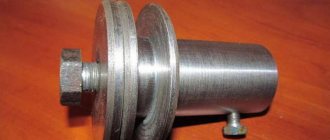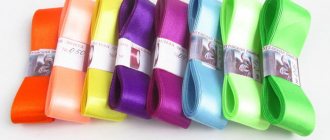Almost every professional chef uses a custom-made knife for his work. The cost of such a customized instrument ranges from $200 to infinity. Looking at this price, many people get upset and forget about their dream. However, there is an alternative solution - to make a kitchen knife with your own hands. This process is not as difficult as it might seem at first glance, but it requires patience and desire. Manufacturing without additional costs takes about 20 hours, be prepared to sacrifice your personal time.
Homemade kitchen knife.
A knife can be made from anything
Today, I would like to continue the topic of accessible material, from which it can be made quite quickly and easily with good characteristics.
Many people are interested in the question of what can be made from without resorting to complex technologies. This is written about in some detail in. Here we will try to further highlight some of the details of suitable material for knives. The easiest thing is to use old broken stainless steel kitchen knives. Knives should preferably be Soviet-made, and not Chinese consumer goods. From such a fragment you can make a good knife with excellent cutting characteristics. Also, good knives can be made from high-speed steel, which is used in the production of hacksaw blades for power saws. The disadvantage of this material is that it is quite fragile and tends to rust. But it holds an edge well.
An excellent material is knives for a wood planer. This metal is very well processed and polished. The planing knife is burned red-hot with a blowtorch and then cooled. After annealing, the metal can be easily sawed with a hacksaw, shaped, or sharpened with a file. After the knife is given its final shape, it needs to be either in oil or water. But, unfortunately, knives made of this metal also rust.
The next metal we'll look at is a regular file. It is very easy to make a knife from a file, without any special machines. Take a file, heat it well, again with a blowtorch until red-hot, and let it cool. After this, it is very well processed with another file, sawed with a hacksaw to give it the desired shape. Next, hardening is carried out again in oil or water. The main thing is that in order to get a good knife from this metal, you need. There is no need to unforge this metal. We simply burn, sharpen, file, remove excess metal with a hand tool or sandpaper. And we get a pretty good knife.
You can also make it from an ordinary hacksaw for wood. It is also very easy to process, very elastic steel. It can be adapted, for example, to make a kitchen knife that will cut well and hold an edge well.
A car spring is also well suited for manufacturing. The only bad thing about a spring is that it needs to be unchained and properly heat treated. This is quite a time-consuming task. But if you build a homemade forge on your property, you can make a good knife from a piece of spring. Or just take it to the blacksmith, who will forge anything for you for a bottle of vodka. You can make a knife from a car valve. It also makes good stainless steel. The valve is heated to high temperature and hammered on an anvil. Then you need to shape the blade and harden it.
Very good knives are made from large drills. Clamp the drill in a vice, heat it until soft, take the gas keys and begin to slowly unscrew it. After this, you heat it up again and begin to unforge the resulting part, giving it the desired shape. The drill will not be sharpened with a file. All work must be done on sandpaper.
The knife can be made of spring steel. There is no need to anneal this metal. You can immediately make a knife blade from the workpiece. This steel cannot be drilled with a regular drill. It is necessary to use a pobedit drill.
Now let's talk about rust, which is present in most metals. If you want to prevent your knife from rusting, you can treat it with sulfuric acid or phosphoric acid.
The article uses material from a video on YouTube
One of the main elements of working in the kitchen is a kitchen knife. It would seem, what could be simpler? But not every housewife knows what they are and why to use one or another type.
Especially for you, we have prepared a selection of the main types of kitchen knives and their purposes with photos and brief characteristics. Let's try to figure out which of them are really needed in the kitchen, and which ones will be useful only occasionally and will simply take up extra space.
History of development from stone to modern
Man first began to use a knife immediately after he stopped walking on all fours and began to get food with improvised means. The tools that people began to use for hunting and farming were fragments of bones or stones. The first ones were much easier to make, due to the fragility of the animal’s bones, but such products dulled unusually quickly, and not all components of the skeleton were suitable for the role of a sharp instrument.
To make a knife from stone, primitive man had to put in a lot of effort. However, the laboriousness of the process was compensated by its relative strength and the ability to sharpen the edge of a stone blade. Another advantage of a stone knife over a bone one was the durability of the tool. Bone weapons were fragile and often broke during hunting, so this type gradually passed into economic use and construction.
At the time of human mastery of metalworking, edged weapons began to be made from bronze and copper. They were significantly superior to stone samples in terms of durability. The blades were made from a single piece of metal. Swords, daggers, and knives of those times became indispensable weapons for the soldiers of the Roman Empire, with the help of which troops conquered new territories.
The Iron Age is the age of experimentation and new technologies. Knives acquired different shapes and lengths; at this time, sickle-shaped and wave-shaped blades were invented. In Rus' at that time, edged weapons were included in the attributes of the nobility and merchants. The Vikings used wood to make sword hilts so that the steel, frozen in the cold, would not burn the hand.
In the Middle Ages, people began to use steel - an alloy of iron and carbon - in the production of swords. These times were considered bloody; history knows many large-scale wars and battles. As a result, the emphasis in forges was not on quality, but on quantity. And in comparison with ancient times, the characteristics of the samples of edged weapons of the Middle Ages were much inferior to the ancient prototypes.
During the Renaissance, the experience of blacksmiths, passed down from generation to generation, together with new technologies of that time, resulted in steel cutting products of quite high quality. But just at this time, firearms began to be used in battles, and interest in blades began to gradually fade away.
During the Industrial Revolution, the production of bladed weapons became widespread, moving from handicraft to factory production.
In factories, the manufacturability of the process reduces costs, which means that the product becomes cheaper and is already available to almost everyone. Soon, folding knives and world-famous centers for their production appeared - Russian Zlatoust, English Sheffield, German Solingen and Swedish Eksilstun.
Main types of kitchen knives
Despite all the diversity, three knives are rightfully considered the main chef's troika, without which the cooking process seems extremely complex and labor-intensive. Let's take a closer look at each of the knives.
Chef's knife. A universal tool that can replace most other knives - except, perhaps, a bread knife. However, many chefs make do with only them - a matter of technique. A fairly large, heavy knife, despite its size, is easy to use. Shredding vegetables, slicing meat, peeling fruit... All this can be easily done with a chef's knife.
A wide blade, eighteen to twenty-five centimeters long, should be perfectly sharpened and quite durable. Durability is essential for handling frozen foods.
Considering that the highest demands have always been placed on the quality of this knife, we have prepared for you.
Another important component of the “big three” is a bread knife with a serrated blade. The length of such a knife is about twenty-one centimeters. Its characteristic feature is a blade similar to a hacksaw, processed using the serrated sharpening method. The specially serrated blade easily cuts the bread pulp, but does not crumble it.
The last required tool is a small paring knife, with a blade of about seven to eight centimeters. Its small size allows you to hold it comfortably in your hand and thoroughly peel potatoes, zucchini and other vegetables or fruits - something that is difficult to handle with larger knives.
Features of sharpening the finished product
Sharpening the blade will be correct only if the angle of the blade to the block is chosen correctly. The main principle for choosing a sharpening angle is that the smaller the sharpening angle, the sharper the blade, and the larger the sharpening angle, the longer its sharpness. The universal angle for sharpening is an angle of 20º, but if particularly desired, the master can rely on the following generally accepted values:
- an angle of 30-35º is selected for hunting and folding knives;
- angle 40-45º - for knives that require edge sharpness and increased resistance to dullness;
- 25-30º - angle for household knives;
- 25-40º - selected for sharpening tactical knives.
Sharpening a handmade knife
Sharpening a knife should be accompanied by smooth movements. When sharpening the curve of the blade, you need to slightly lift the handle of the knife, which will create the same sharpening angle around the perimeter of the cutting edge. The direction of the blade should be such that the direction of movement is always strictly perpendicular to the cutting edge.
Popular types of knives
Of course, these are not all types of knives for use in the kitchen. If you go to a specialty chef's store, the variety of knives will amaze you. We suggest studying in more detail those of them that can become a successful addition to the main chef’s troika.
Perhaps the first place on this list should be a universal knife, which is found in almost every home. The classic-shaped blade usually reaches fifteen centimeters. This knife is suitable for both meat and vegetables. It is easy to use and does not require special skills. However, such a knife will not cope with soft or, on the contrary, too hard products.
Few people know that the potato peeler found in almost every home is actually also a type of knife. A vegetable peeler, to use the official terminology, thanks to two blades facing each other, is very convenient for peeling vegetables and fruits. Floating blades provide additional ergonomics - such a knife will tire your hand much less than if you were trying to peel potatoes or apples with a regular knife.
Another useful knife is a kitchen hatchet. A wide square blade up to eighteen centimeters long is indispensable for chopping meat. Due to its high strength, it allows you to easily cut through large pieces of meat, including frozen ones.
Its peculiarity is also interesting: if most knives need to cut along the product, such a hatchet should be lowered deeper.
Important: if you decide to purchase a kitchen hatchet, pay attention to the handle! It should be comfortable and not slip in your hand - otherwise you may get injured.
For non-professional home cooking, it would be a good idea to purchase a small sandwich knife with a slightly rounded blade. Who among us doesn’t like to make a couple of sandwiches for breakfast or for evening tea?
The unique shape of such a knife will allow you to conveniently spread butter and other soft foods on bread: pates, processed cheese, soft cottage cheese or mousse, jam...
A wide eight-centimeter-long blade will make it much easier for you to prepare sandwiches.
A fillet knife with a narrow and long blade of twenty centimeters is also useful in the kitchen. The shape of the knife and the raised tip make it easy to fillet fish, separate the fillet from the bone, and cut the meat into thin slices. But be careful: this knife is not suitable for hard foods, so avoid cutting frozen meat or fish.
The Japanese santoku knife is not very popular here. Oddly enough, this convenient wide twenty-centimeter knife is not very famous. But Americans have long appreciated it - many professional chefs are switching from chef's knives to santoku. And in almost every home you can find such a model.
Thanks to the lowered tip, the knife is more ergonomic than its chef counterpart. It is convenient for chopping or shredding meat. The tip allows you to delicately cut even the most capricious products, including bread.
Another less popular knife will come in handy for many cheese lovers. That's what it's called - cheese. It is better to use it for soft varieties - a universal or chef’s knife can handle hard ones. The grooves or holes on the knife blade allow you to cut soft cheese without deforming or sticking. A nice bonus is that at the tip of such a knife there is often a small fork for carefully transferring the cheese to a plate.
Unusual knives
If you really love to cook without being intimidated by experiments and unconventional dishes, you should be interested in the following types of knives. They are not so often used in the home kitchen, but they can make life much easier for an enthusiastic cook.
For lovers of stuffed vegetables, a cavity cutter will undoubtedly come in handy. The oval shape of the blade looks unusual, but once you pick it up, you will understand how convenient it is. The pointed edge allows you to quickly remove the pulp from zucchini, eggplant and other vegetables. If you wish, you can even prepare pieces of meat for stuffing - but for this it will be more convenient to slightly freeze them.
Another interesting model is a cucumber knife. However, with its help you can quickly cut any hard vegetables or fruits into thin, neat slices. Seven parallel blades ensure a clear and precise line, so your plate of fruit or vegetable slices will look perfect.
The so-called chopping knife is also interesting to use. The semicircular blade is crowned with two handles. It is recommended to work with it with both hands. This knife is suitable for cooking chopped steaks, quickly chopping large quantities of meat or vegetables, and so on.
The knife is often used in professional kitchens, but amateurs are wary of it. And in vain. Yes, working with chopped meat requires certain skills - but after spending a couple of hours training, you will notice how much easier it has become to work with chopped products.
The popularity of Japanese cuisine could not but affect the Russian kitchen appliances market. If you love sushi bars, why not try making their menu at home? A kitchen sashimi knife, thanks to its flexible long blade (about twenty centimeters), will allow you to cut salmon and any other fish into thin, almost transparent slices. Your sushi will look perfect!
Sushi's eternal competitor is pizza. Fans of hot flatbreads with cheese are familiar with trying to cut a hot product fresh out of the oven. The cheese stretches unsightly and sometimes falls along with the filling... To avoid such troubles, purchase a round pizza knife. The rotating blade with fine teeth allows you to quickly cut pizza into neat, aesthetic slices.
Of course, we could not describe all types of knives - experts number up to two hundred. However, we hope that the selection will help you decide on the necessary minimum, which will greatly facilitate the cooking process and make work in the kitchen quick and enjoyable.
Knives are currently popular not only in the kitchen, but also among people who have connected their lives with extreme types of active leisure - fishing, hunting, tourism, etc.
There are various knives on the market today: variable models, different sizes and designs. But none of them can replace a knife that you make yourself.
People often write on the Internet about how to make a knife with your own hands, but you have to try hard to make them.
Preparing all the details
At this stage, you need to make a hole and cut threads where the screws will be installed in the handle. You also need to warm up the holding lever and bend it to fit it into the handle.
Since ejection of the blade is ensured by a spring, we wind it around the axis of rotation of the blade - after this, it is necessary to cut out a seat for the spring in the PCB on the inside of the handle.
To do this you will need a drilling machine. We attach the spring itself to the blade with one end, and to the handle with the other, having previously drilled holes.
We weld a bolt to the trigger lever - this is the same “handle” that will activate the rotation of the blade. Cut off the excess part of the bolt. Next, you need to install the resulting “handle” into the handle of the knife - you need to carve a round groove for it.
Another spring in the handle supports the lever—for it, a stop is machined and installed, which we attach to pins or nails. With a simplified version of manufacturing - a folding knife, a trigger mechanism is not needed.
Blade hardening
If the blade is made of N690 steel, then its hardening temperature is 1071 degrees Celsius.
Since few people can boast of having an industrial oven, such an operation can be done with a torch “by eye”.
At this temperature, the steel has a yellow glow. Alternatively, you can use a magnet to determine the desired temperature regime - if the workpiece is not attracted to the magnet, then you can stop heating. Cooling is carried out in mineral/vegetable oil. By the way, in addition to the blade, it is also worth hardening the lever.
Blade hardening.
To stabilize the stresses in the metal, we conduct a tempering process - the temperature is 200-300 degrees Celsius, holding time is 1 hour. A regular home oven is suitable for this operation. We leave the blade to cool in a closed heating chamber.
You can check the quality of the result with a file - there will be no scratches on properly hardened and tempered steel. After this, the blade can be ground, polished and sharpened - seal the finished blade with electrical tape.
Assembly
It is necessary to install springs, a lever and a blade into the handle - we connect the halves of the handle with screws. To make the handle smooth, you can “recess” the screws by pre-drilling grooves for the heads.
After this, the handle can be sanded and polished with a special nozzle - the aluminum surface will look impressive.
It is clear that to assemble a simple folding knife, you do not need to mount a spring. Despite all the convenience of switchblade and folding knives, they have one serious drawback - if dirt gets inside the handle, and therefore the mechanism, the tool may fail.
So switchblades and folding knives made by yourself require careful handling - only in this case will they last a long time.
Previous Making knivesHow to make a knife from stone Next Sharpening knivesHolder for sharpening knives with your own hands
Knives: types and basic properties
In the photographs of the knife on the Internet, you can see that each product is a creative element created from various mechanisms.
There is a large classification of knives depending on their functionality: combat, tourist, folding (for example, butterfly), knives designed for hunting, multi-tools, bivouac knives, as well as ordinary kitchen knives.
Kitchen knives are bought ready-made, but knives intended for hunting or tourism can easily be made at home yourself.
There are also such knives as survival knives, the main purpose of which is to help one survive in the wild. This option is relevant for tourists and hunters.
The blade of such a knife is usually no more than 12 cm. This length is sufficient for cutting wood, processing game, cleaning fish or other similar actions. Small dimensions make this knife easy to transport.
When making such a knife, great attention should be paid to the material intended to create the blade. Steel is often preferred.
Basic materials for production
The material of manufacture plays an important role when choosing a product. One of the most popular is wood. A wide variety of breeds are used. Thus, a light and practical handle can be obtained from dense maple, walnut, cherry and oak. Options made from tropical trees are reliable to use, but have a higher price.
Other natural ingredients are also used to form the handles. Hunting knives are often decorated with the horns and skin of wild animals. The most common synthetic components are nylon, fiberglass, greyvari and carbon.
An excellent electrical insulating material is micarta - a polymer-type film with a resin base. Glued with fabric or paper with electrical insulating components. Micarta is distinguished by its pleasant appearance, moisture resistance, ease of processing and long service life.
One of the varieties of rubber, kraton, is used both as an insert and as the main element for the handle. It is characterized by high wear resistance and increased grip tenacity due to its anti-slip properties.
Less commonly used is G-10, a fiberglass laminate made from epoxy binders. The composition was originally developed for the production of circuit boards; today it has found application in handles. Advantages: high dielectric properties, moisture resistance, non-flammability, rich color range. A sharp decrease in temperature can lead to a decrease in the strength of the product.
Read with this
Knife design
Because it is by the handle of the knife that others can then judge your creative thinking and status.
Some write their names on the handles of the knife, draw certain patterns and sketches in the form of tattoos.
The simplest knife can be built in an emergency in the forest; the main thing is to find the materials necessary to create it.
Note!
You just need to find the cutting part for the knife, and then you should insert it only into the handle, which will be in the form of a piece of wood, rope or leather.
Photo of a knife with your own hands
MAKING KITCHEN KNIVES
Having reworked a lot of all sorts of cold, piercing and cutting things, I suddenly noticed that there was no good kitchen knife in the kitchen. Well, then let's start making it. First, let's decide on the workpiece: you can take 65G or 95X18 steel. I do not consider other options due to their lower quality and low prevalence. If there are problems with the workpieces and subsequent hardening, you can simplify the process by using a piece of a saw blade or other metal-cutting tool for the knife. Using an emery wheel, we give the iron the desired shape. First scratch the outline of the knife according to the template. I use cut out fiberglass templates for this.
After removing excess metal, we add shine using a circle with sandpaper.
Having drilled two or three holes with a diameter of 3 mm for fastening, we get this:
Now it's time to work on the handle. Some use plastic for these purposes, some use caprolon, some plexiglass, some metal. But the best results come from simple wood - it’s durable, comfortable, and pleasant to hold. For the preparation, take a wooden leg from a chair. Cut in half with a hacksaw
These two halves will be the handle of the knife. The fastening is done using rivets made of aluminum wire.
Having firmly attached them to the iron, we drill the mounting holes and place them on M3 screws for subsequent processing.
To give the handle a preliminary shape, we use an abrasive grinding wheel.
Already something similar to a knife. Now you can replace the screws with rivets. We finally shape the handle with a rasp and polish it with a strip of sandpaper, first coarse-grained and then finer.
We are not always satisfied with the quality of the purchased instrument. Sometimes the best option is to make what you need yourself.
The knife is an object that has become firmly established in our lives. There are many photo instructions on how to make it. Definitely, this is a labor-intensive process and not everyone can make a good blade at home. But made with your own hands, it will delight you with its quality for many years.
Determination of sharpening quality
The best way to test the sharpness of kitchen knives is the so-called “tomato test”. To do this, take a ripe tomato, from which, without pressing, cut off a slice from the very edge of the vegetable. If the skin is cut easily and without any effort, then the knife is sharpened well.
If the blade is not sharpened well, it will simply slide off the rounded surface of the tomato, and cutting a piece will require force, crushing the vegetable.
Tools
Selecting from the available equipment what is needed to make a knife is not so easy. Some tools will have to be purchased or rented additionally. However, a lot depends on the technology.
To make a knife by hand forging we will need the following:
- Large and small hammer;
- Bake;
- Coal;
- Blacksmith's tongs;
- File;
- Pliers;
- Sandpaper;
- Adjustable wrench;
- Grinding and grinding machine;
- Anvil;
- Bulgarian.
List of steps and preparation of everything needed
The entire manufacturing process can be divided into several parts for a more complete perception of information:
- selection and preparation of materials with tools;
- template selection;
- choice of steel;
- shaping the workpiece;
- heat treatment;
- knife sharpening;
- making a handle.
Each of these steps is associated with health hazards, so each stage should be approached carefully and thoughtfully, following all safety rules.
So, to create a really high-quality knife, we need a list of such materials (if you have experience in this matter, you can use an alternative):
- steel;
- tree;
- brass rivets;
- gypsum;
- iron sieve;
- gas-burner.
Tools:
- Metal file.
- Hacksaw for metal.
- Hand drill and drill bits for it
- Permanent marker.
- Metal scissors.
- Hammer.
- Kerner.
- Long nose pliers.
- Gloves.
- Nozzle.
- Metal or plastic brush.
- Miter box.
- Saw on wood.
- Sandpaper.
- Clear varnish or stain.
Drawing of a kitchen knife.
Metal selection
Before moving on to detailed instructions on how to properly make a knife, it is important to carefully select the material from which it will be made, taking into account all the necessary technical characteristics:
- Wear resistance (resistance to abrasion and deformation; depends directly on hardness);
- Ability to withstand high temperatures;
- Strength (maintaining integrity when a certain external load is applied);
- Viscosity (the ability to hold its shape without deformation or destruction during use);
- Hardness (the ability to resist the penetration of foreign materials into its own structure).
Blade making
The work technology will depend on what kind of workpiece is used for the knife. You can buy a sheet of metal (plate) of a certain thickness at a hardware store and cut a blank according to the sketch. Temper the metal in a furnace. Then process it with a file or on a grinding machine.
It will be much easier when the blank for the future knife is made from:
- Old braid;
- Lawn mower blade;
- Double-sided file;
- Drills of suitable diameter.
It is important that the workpiece is thicker than the final blade obtained after processing.
Knife handle
What you can make a knife handle from is limited only by your own imagination.
Ancient craftsmen sought to make their blades a model of perfection, using all the available material at hand. Original ideas for knife handles using whatever is at hand change over time.
Currently, a knife handle can be made from the following materials:
- Plastic;
- Plexiglas;
- Tree;
- Ceramics;
- Ebonite;
- Quartz glass;
- Bronze;
- Silver;
- Ivory;
- Gold;
- Textolite;
- Antler.
File knife
Let's take a step-by-step look at the process of making a blade and handle from a simple material that can be found at hand. From a two-edged file.
- We preheat the metal in the furnace;
- We give the workpiece the desired shape according to the drawing. We use a blacksmith's hammer, then a sharpener. Ultimately, two clearly distinguishable zones should form - for the handle and the blade itself;
- We perform rough (rough) sharpening of the knife for a razor or blade type knife;
- We make handles from any material. Cut it to the size of your own hand.
- We bring it to the desired shape on a sharpening machine;
- We dock the handle with a metal blank (with rivets);
- We grind and polish the knife (with sandpaper or a grinding machine with the necessary attachments);
- We perform final sharpening of the blade;
- We use velvet cloth or polish to give the knife its final finished look.
Handle making and assembly
Various materials are suitable for making the handle: wood, plastic, animal bones. The method does not require any unique skills. There are already holes in the shank of the knife for attaching rivets. For beginners, it is recommended to make it from wood - it is the simplest. The process looks like this:
- Having found a wooden block that is suitable in length to the shank, it should be divided into two equal parts . They will be mounted from different sides.
- Parts applied to the metal should be sanded until the workpieces fit tightly to the shank .
- Plan the rough wood in advance for the finished handle . Fine adjustments should be made at the final stage.
- Mark the pads for the holes . According to the shank. Drill them out.
- Generously coat the metal and handle blanks with epoxy glue. Assemble the structure .
- Pass the prepared wire rivets into the holes and rivet with a hammer .
- Squeeze the product with clamps over the entire surface of the handle and leave to dry for a day.
- After drying, it’s time to adjust the handle for finishing . Using a belt saw or sandpaper.
Handle blanks with studs.
After making sure that the handle fits perfectly in your hand, sand it with fine grain. Soak in special oil or impregnation. This will give the handle a natural wood color and water-repellent properties. Which is important for a tree.
Making a scabbard
After the knife is made, a sheath is made according to its dimensions or a cover is sewn together. For this, you can use various materials - plastic, leather, wood.
In the design of the sheath, it is necessary to provide for the outflow of moisture and guides for the blade, and the sheath itself must be made so that the blade can move in and out freely without jamming or any inconvenience.
Thus, making a knife is an entire art, to which in ancient times they devoted their entire lives, achieving the best quality blades and chopping properties. Such knives were successfully used both at the feast and on the battlefield, and each specimen was a model of perfection.











